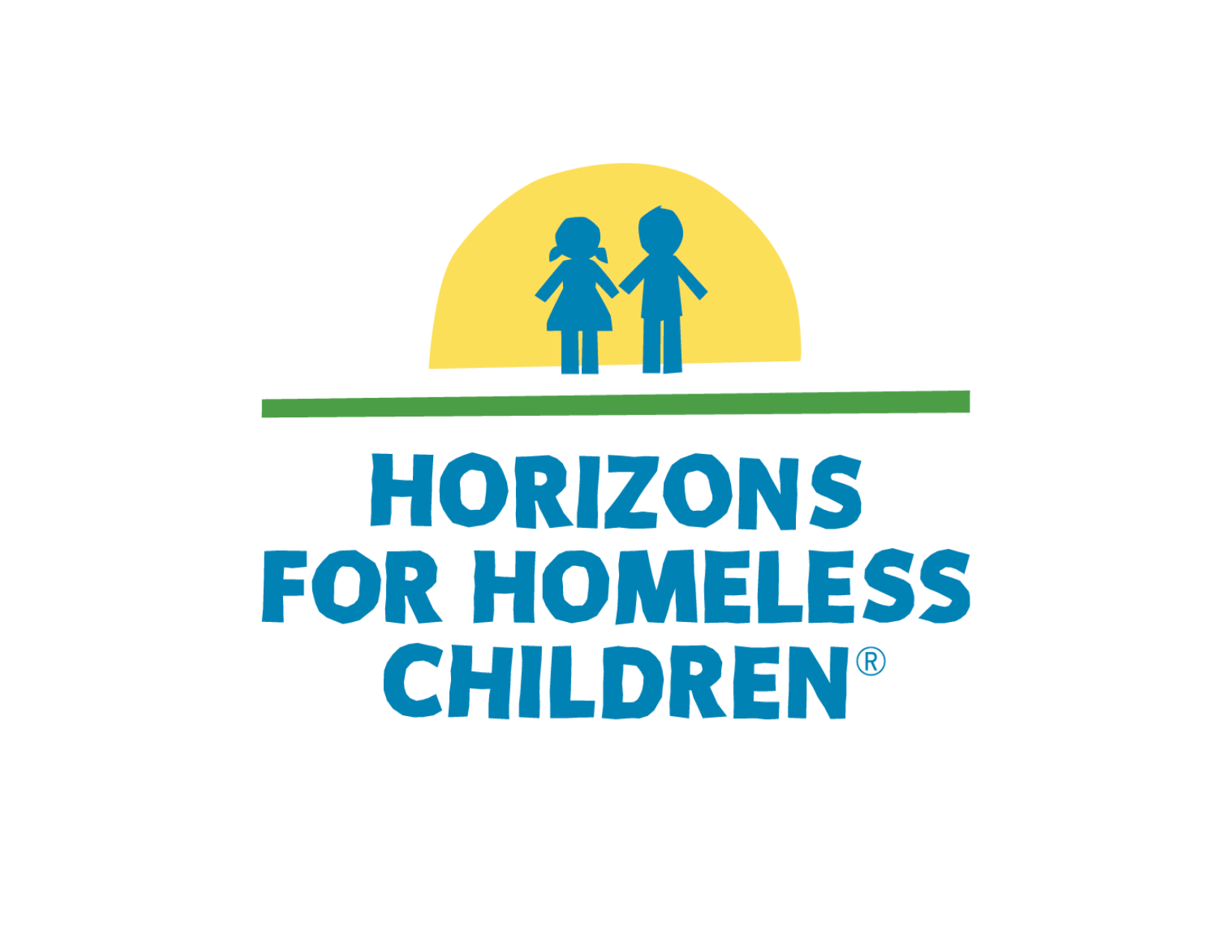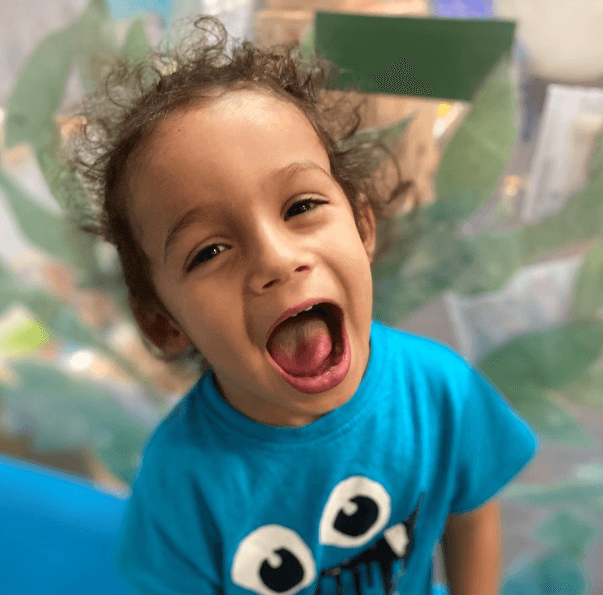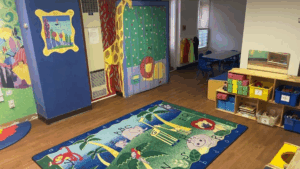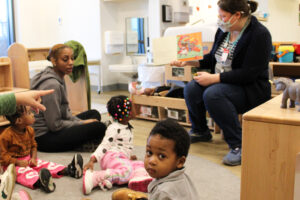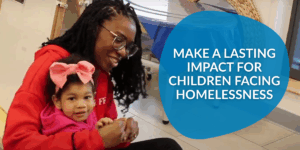Dealing with Feelings
How Horizons’ Toddlers Understand Emotions Through Expressions
For a toddler, the Horizons classroom is an exciting and stimulating space filled with toys, books, teachers, and other students. It can be overwhelming for a young child to navigate as they learn more about themselves and their environment every day. Toddlers in particular enter an important stage where language, understanding, and expression are beginning to connect in the developing mind.

Agnella and her students
Agnella Gross, a teacher in Horizons’ Toddler Two Roxbury classroom was inspired to help her students understand their complex emotions in a simple yet creative way. The seed of an idea was planted when an Early Intervention Specialist visited to work with one of her students on social-emotional milestones and suggested helping the child tie an image to a feeling they were experiencing. Agnella knew her students explored a spectrum of emotions throughout the day and decided the best way to help them connect to their emotions was by seeing their feelings first-hand.
“As toddlers, nearly anything can trigger an emotional reaction,” Agnella explained. From giggling at a funny book to winding down sleepily for a mid-afternoon nap, the range of facial expressions a child exhibits daily is wide. With a background in communication and a special interest in photography, Agnella set to work to photograph each time her students expressed a different emotion. From happy, to silly, to frustrated, to sad, she captured exactly what each child was feeling when something affected them through facial expressions. Using these images, she created a personalized pocket-sized booklet to help her students learn about how they felt.
Paired with each photo is a description of what the child may do when experiencing a particular emotion such as cry when they’re sad or stick their tongue out when feeling silly. Alongside this, Agnella includes a word or phrase the toddler could use to communicate with their teachers and others. Having a physically printed and laminated booklet made it easy to reference whenever an emotion overwhelmed the child.
“They’re so little yet there’s so much going on inside their heads. This book teaches them that there’s a word for what I’m feeling when they have a reaction. It helps to break down their complex emotions into a simple yet effective visual.”
In the classroom, teachers emphasize the phrases in the book to help their students recognize keywords associated with their emotions.
“Are you feeling mad? Did that upset you?” Agnella will ask gently, helping them identify the feelings.
“One of our students has already learned to self-regulate. When he’s mad, he says “I need space!”‘ and we work to encourage healthy ways to deal with those emotions. We’ll say “Okay, let’s find a space for you! Where would you like your space to be?’ He chose the cubby where he likes to take his nap, he feels safe and comfortable there. He’ll curl up with his blanket and we’ll practice breathing exercises – three deep breaths – until he’s calmed down and is no longer upset.”
Agnella personalizes the booklets for each toddler and included the phrase ‘I need space!’ for this particular student to help encourage his self-regulation.
A digital version of the booklet shown above was made available to teachers as a template.
“We have one child who is struggling for words when she feels sad or frustrated. We taught her if she’s feeling this way to ask for help.” The phrase, ‘I can ask mommy or my teacher for help!’ is in her booklet.
Horizons’ trauma-informed classroom works to meet each child where they’re at and personalizing the books based on the student’s language skills helps them connect with the material. Simplified words are the focus for children who don’t have the language skills yet to speak complex sentences while specific phrases are encouraged for those who are ready to expand their vocabulary.
“No matter where the child is with regard to emotion recognition, we always strive to help them understand by saying things like, “There are words for what you’re feeling – let’s try it!’ I don’t expect them to use terms like happy or sad right off the bat but we practice whenever the situation calls for it.”
Agnella has found that personalizing the booklets with the children’s photos helps to encourage their engagement and keeps their attention. “Sometimes the kids will even flip through their book before naptime,” she noted, observing that they’re excited to recognize themselves on the pages.
Each child has an individualized book kept in the Horizons classroom as well as one to take home for their parents to use with them. The project, which was shared internally throughout the organization, was so well received by teachers and staff that it was transformed into a template for other classrooms to use in both English and Spanish languages.
“Creating the book has made me very aware of the temperament of the kids,” Agnella noticed. “In one of my student’s booklet, he’s wearing the same shirt in all of the photos. That’s because he went through all those emotions in one day!”
Smiling thoughtfully at this sentiment, she continued. “They’re an emotional little bunch but it’s usually only a brief moment before we’re able transform their mood into something positive. We also let them know that it’s okay to feel how they’re feeling. Some of the actions might not be appropriate, such as throwing a toy, but we understand if they’re feeling mad or frustrated we can find something else for them to do to regulate such as breathing exercises or a calming activity like stacking blocks.”
Helping the children become more aware of their feelings through this tool has provided Agnella the chance to reflect on the work Horizons provides in their trauma-informed classroom. “My students are a very resilient bunch. I know the background of what they’re going through, yet I see them come into school with the biggest smiles on their faces.” Agnella concluded with a smile of her own, “It’s emotional work, but they inspire me every day.”
This piece was written by Andrea Drag, a regular contributor to Horizons’ Blog.
